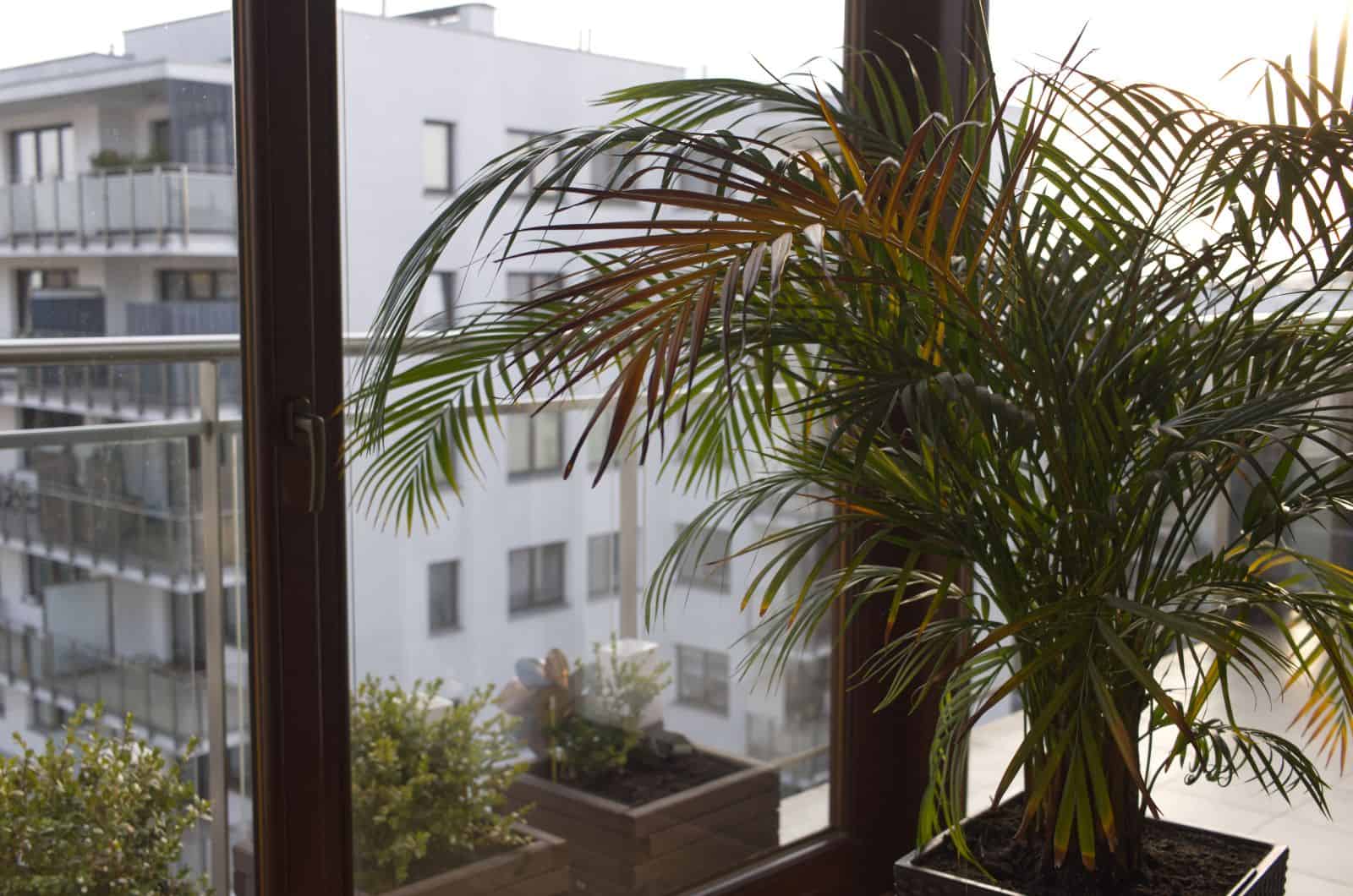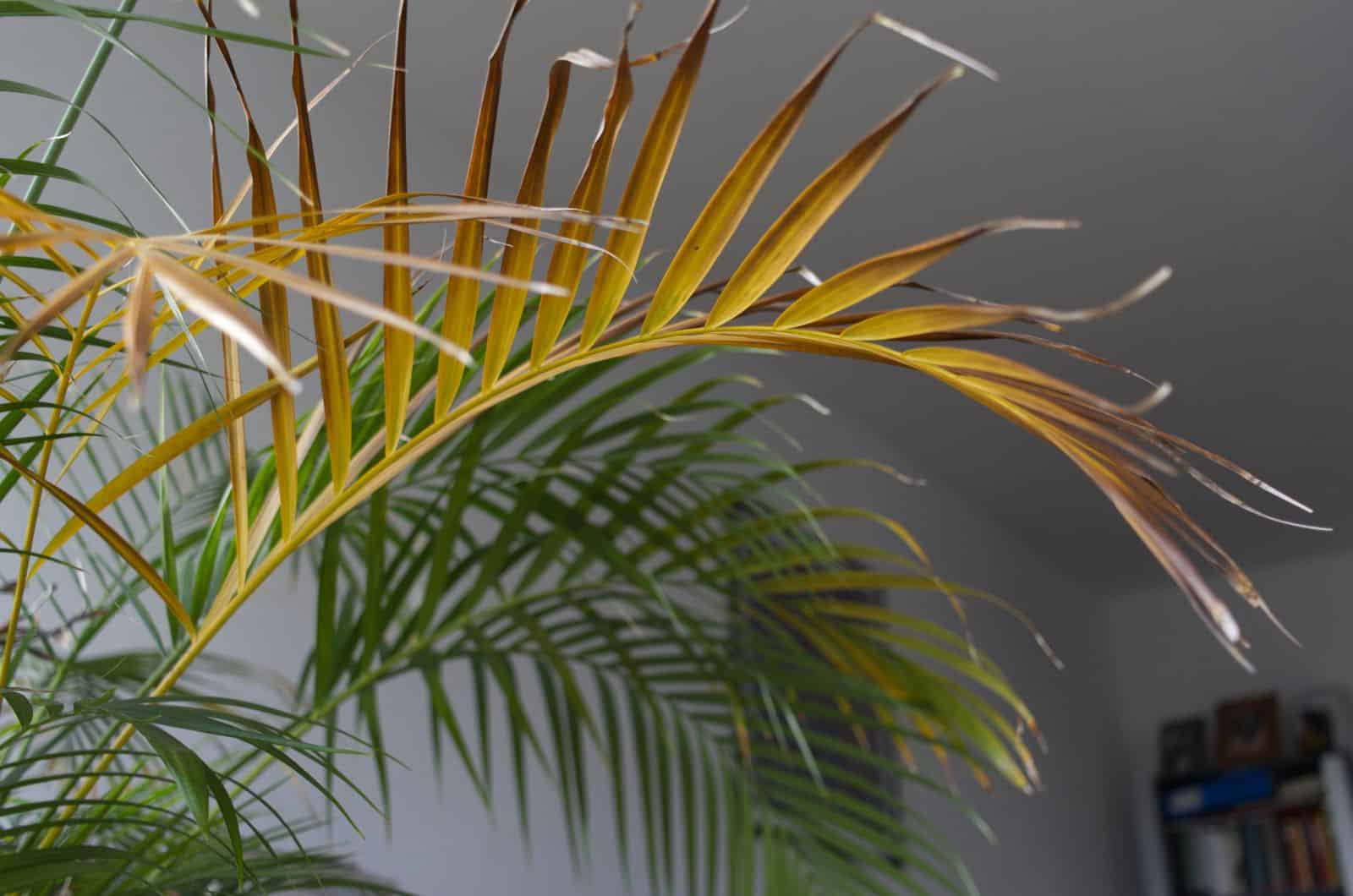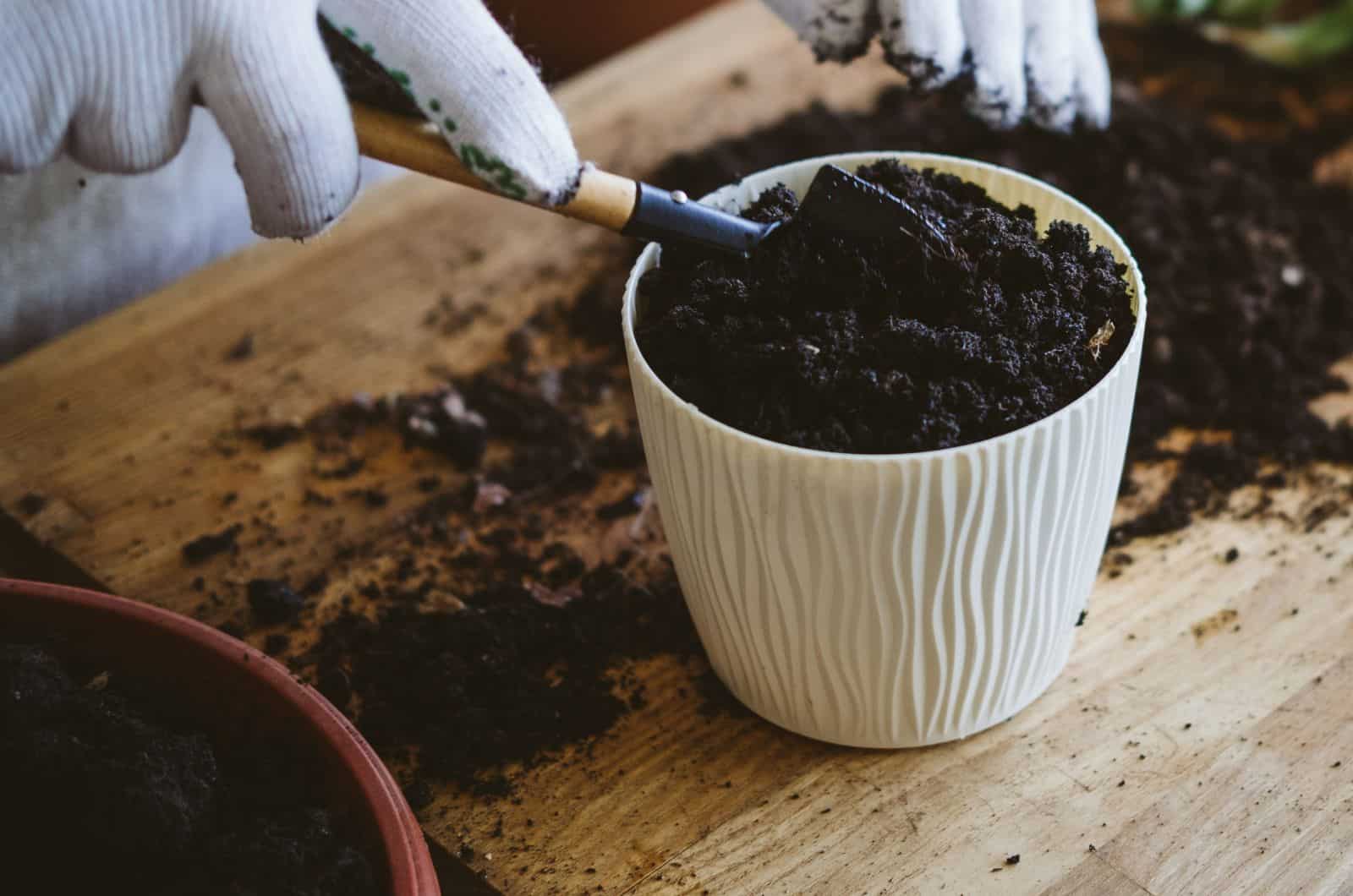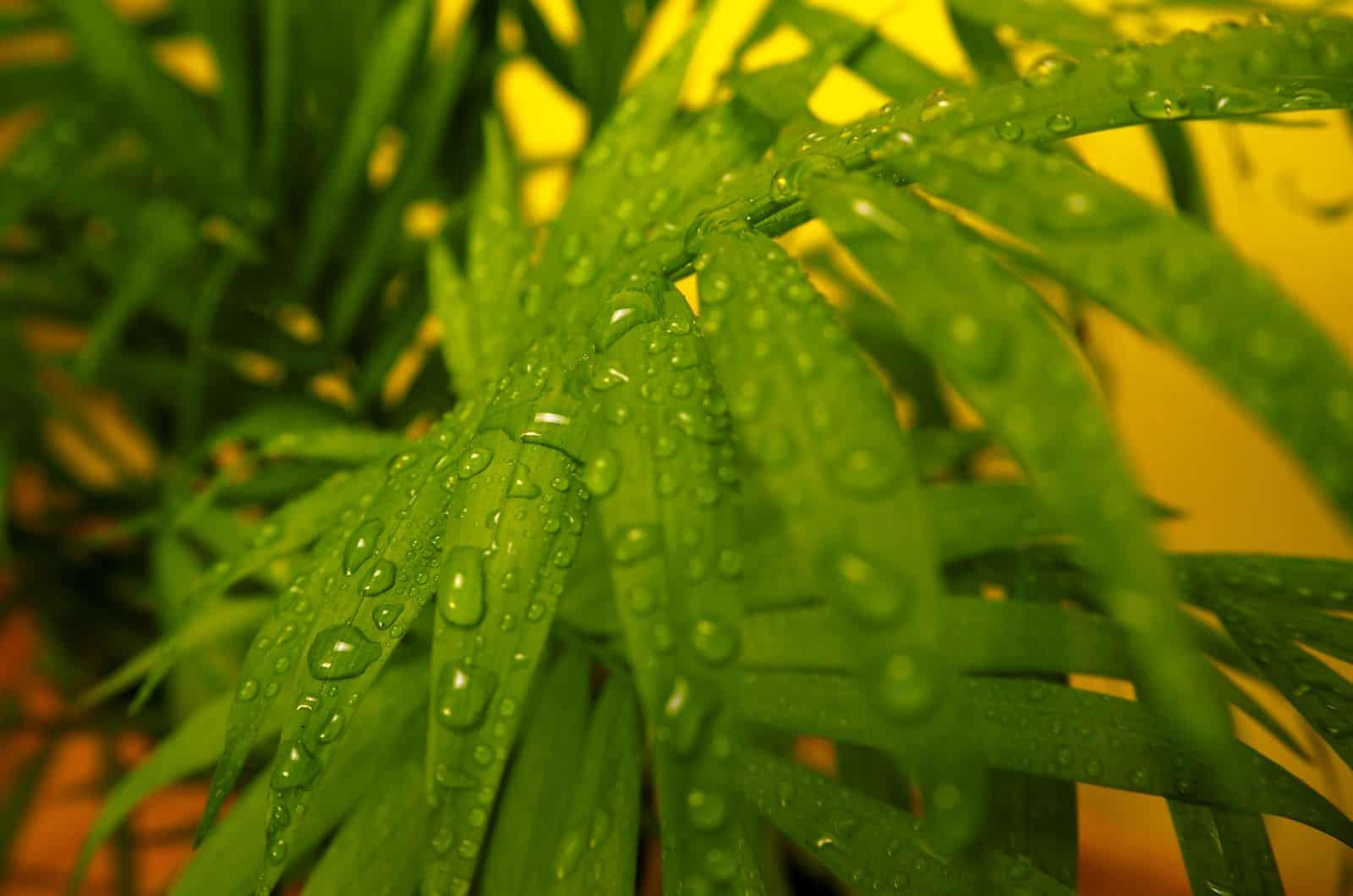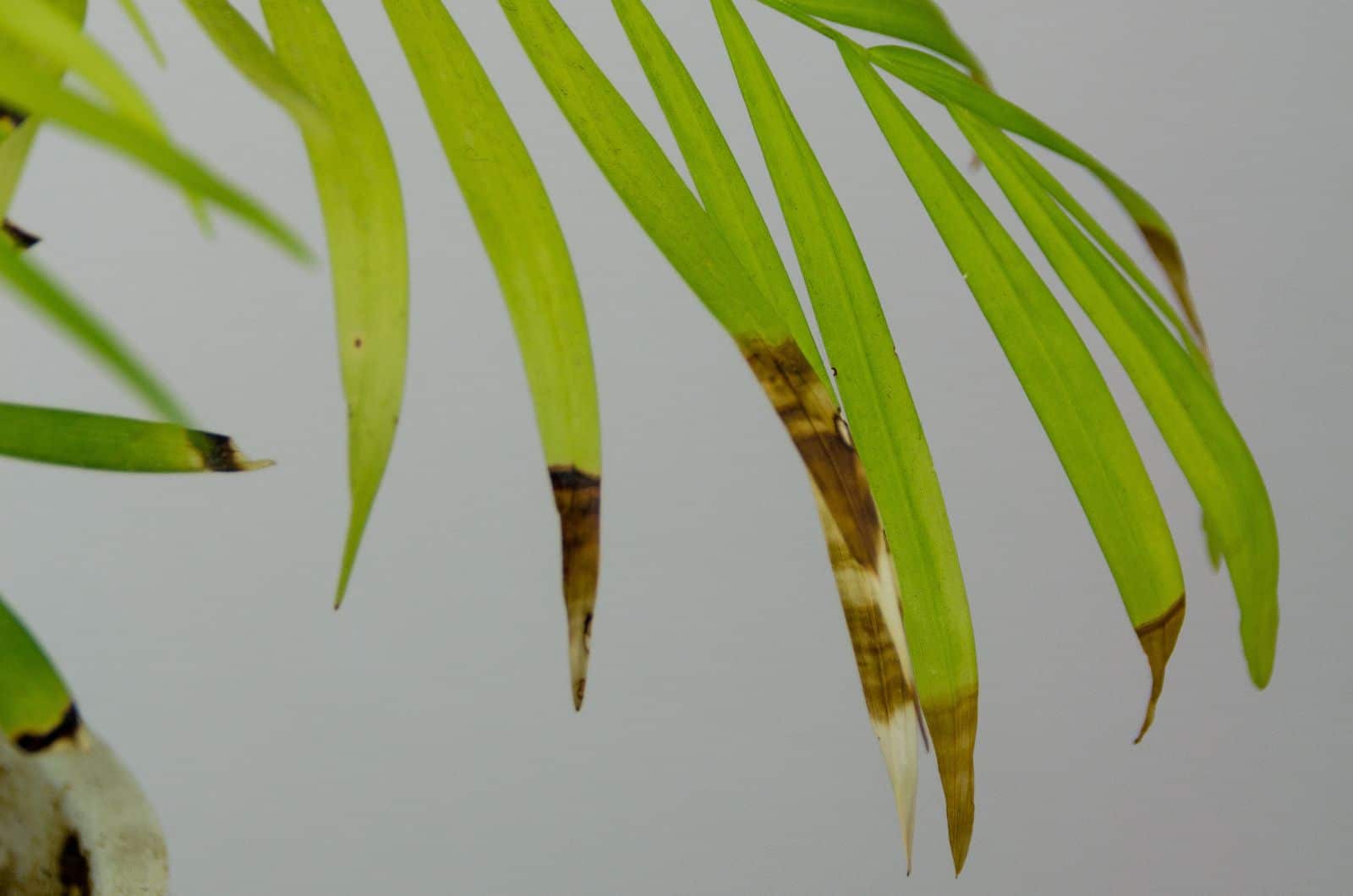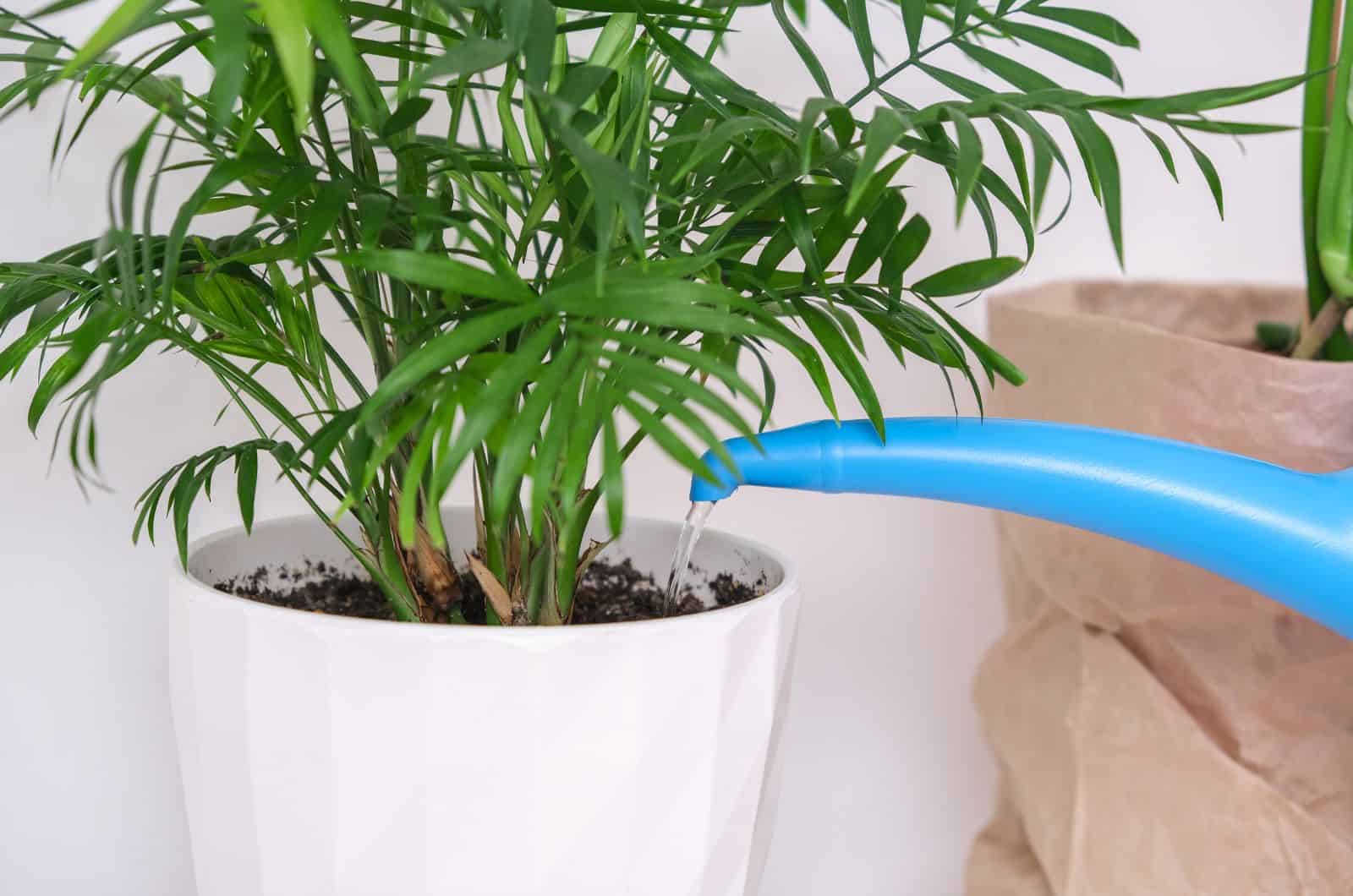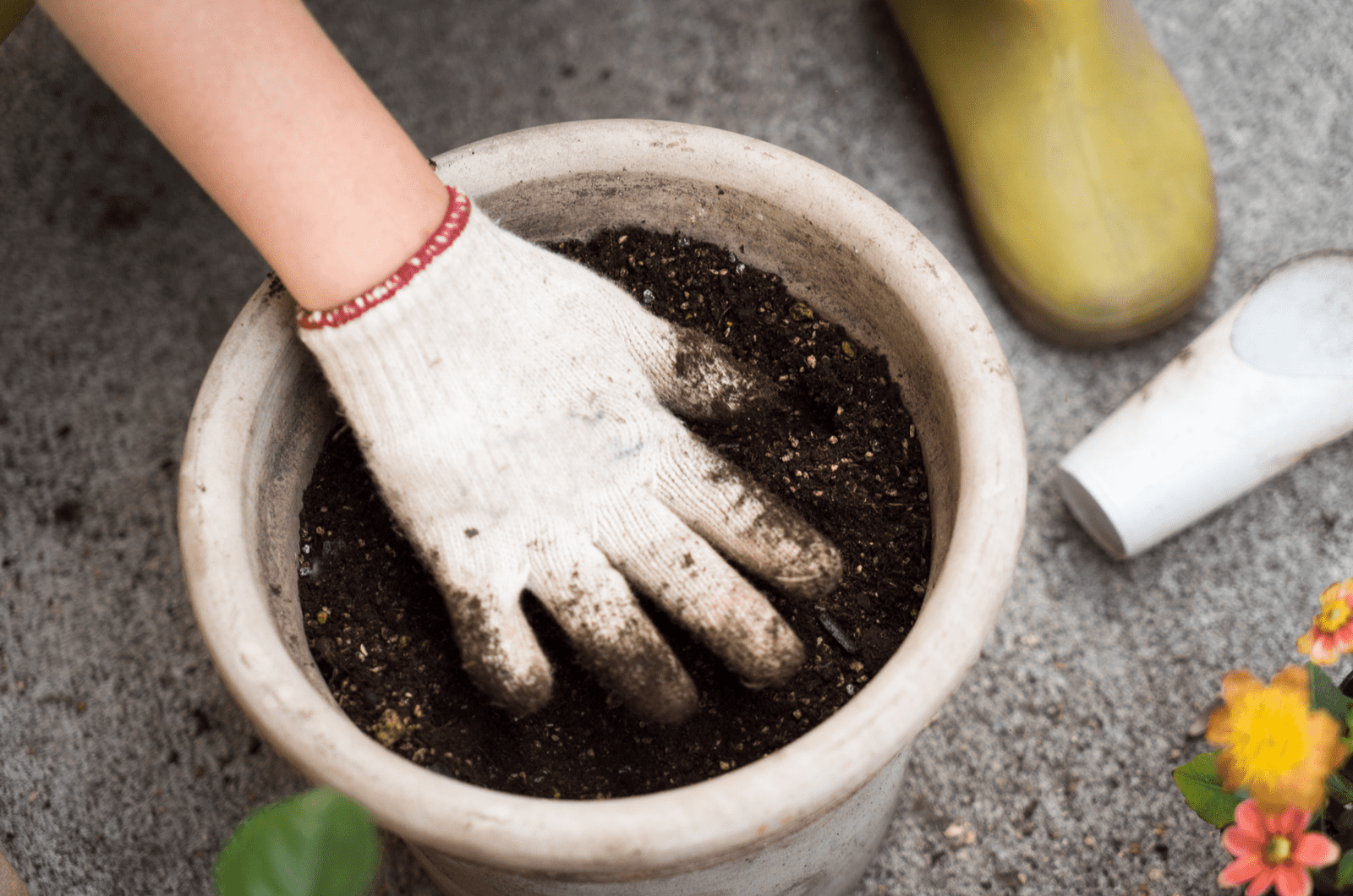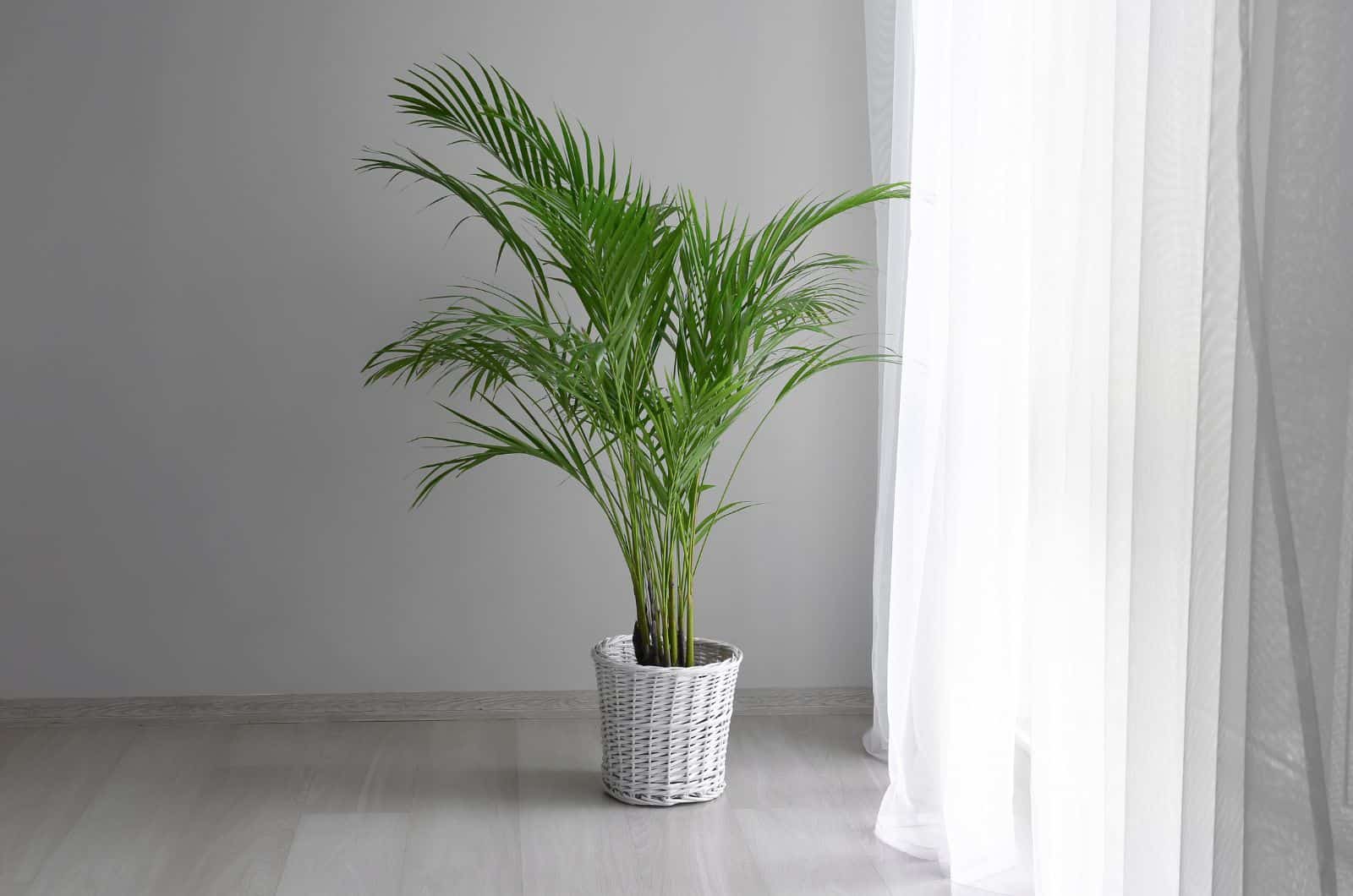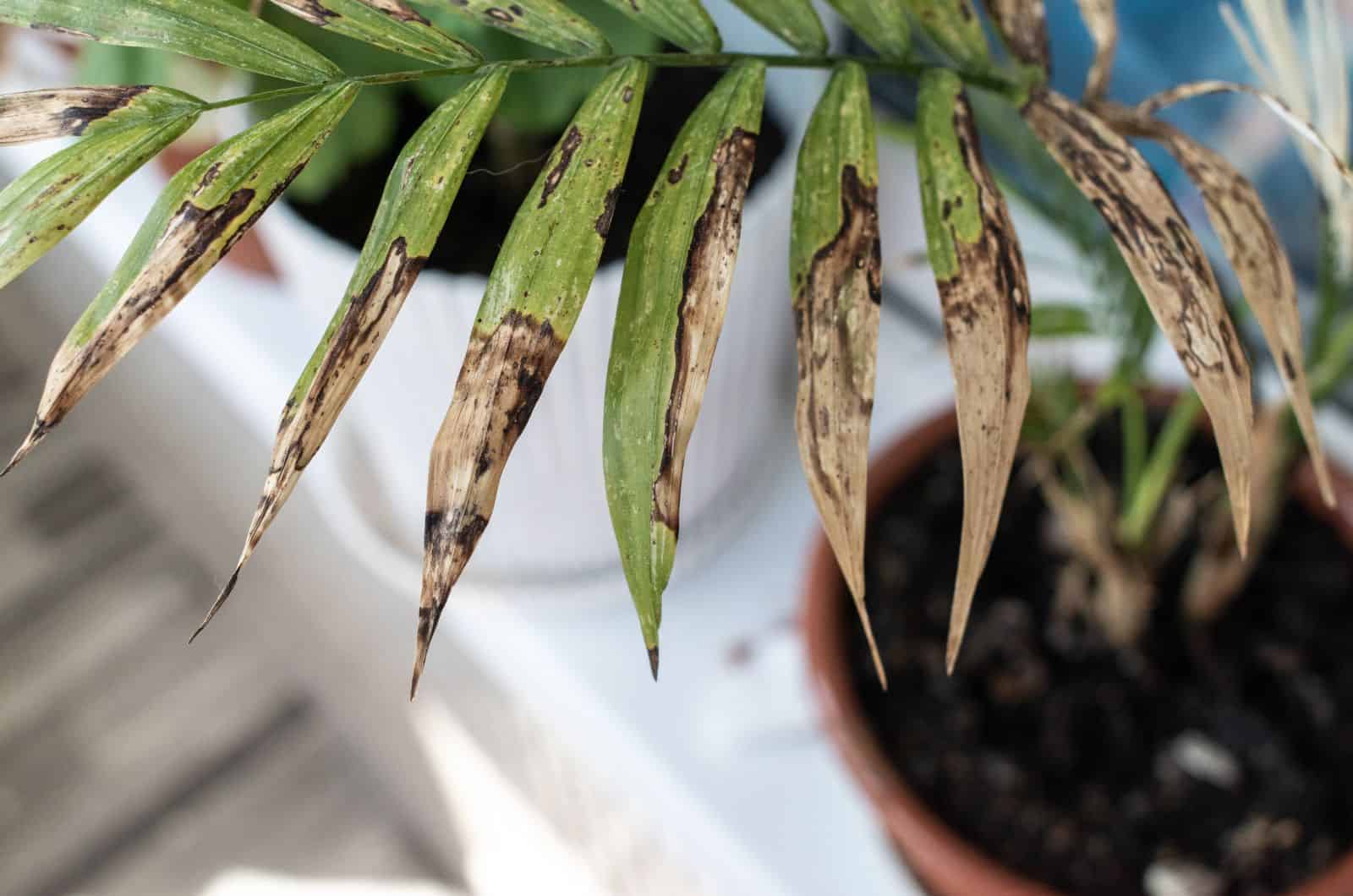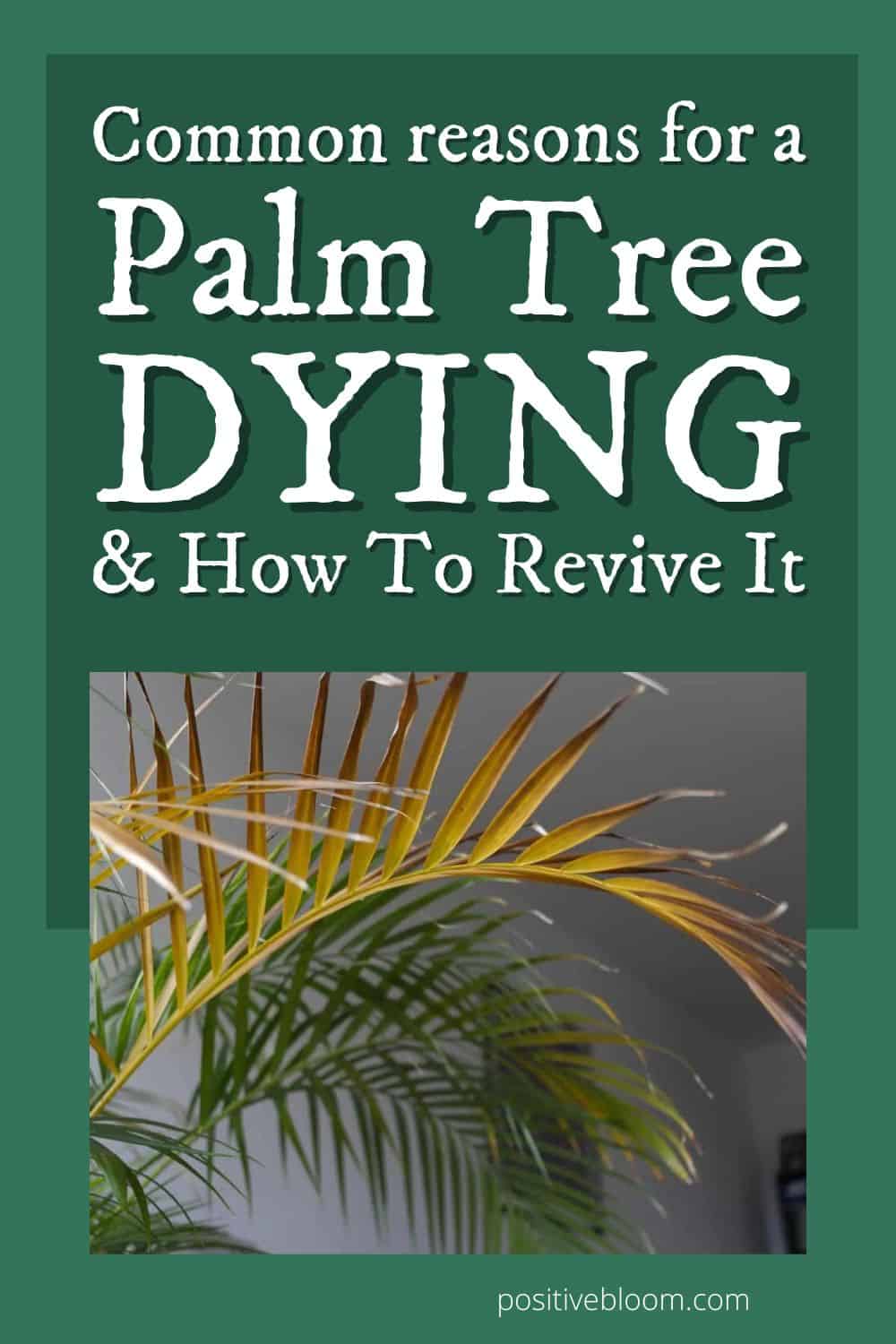Growing an indoor palm tree is a great way to feel like you are on vacation all the time!
Its majestic, green fronds can fit perfectly into any home decor, and these plants are also somewhat easy to take care of. Although they can grow indoors, they start acting up if their needs are not met.
If you don’t fix these issues immediately, you might end up with a dying palm tree!
Luckily, these problems are easily fixed, and your plant will look as good as new. If you want to learn more about the reasons for a palm tree dying and how to solve these issues, keep reading!
9 Reasons For Your Palm Tree Dying
Palm trees originate from tropical regions, and they are used to growing in nutrient-rich and moist soil, bright indirect light, and high humidity. As they are delicate plants, any inconsistencies in their plant care can cause wilting and dying.
Therefore, you must be extra careful when growing this plant indoors. The first sign that there is something wrong is usually yellow palm leaves. The entire plant will then start to look droopy and sad, and we don’t want that!
It is in our best interest to keep our plants happy and healthy, so let’s take a look at some of the reasons your palm tree plant might be dying and how to bring it back to life!
1. Inadequate Watering
Constantly moist soil might be an issue because these plants don’t like soggy soil and are prone to overwatering. However, if you skip a few watering sessions your plant won’t be happy because the soil will get compact and dry, which disrupts the normal functioning of the roots.
If you don’t give your plant enough water, the issue is probably underwatering. On the contrary, if you give your plant more than enough water, you might end up with an overwatered palm tree.
Overwatering
A palm tree that has been overwatered will have yellow leaves instead of lush green leaves.
Overwatering often leads to root rot. If you don’t take immediate action to treat root rot, it could be fatal because this fungal disease completely destroys your plant’s root ball.
The fronds will turn yellow if the roots do not provide enough oxygen. In the event of overwatering, the roots suffocate and the fronds react by turning yellow.
Other signs of overwatering include:
• Brown tips: If the tips of the palm leaves turn brown when the rest turn yellow, your plant is probably overwatered. Act quickly in this case because your plant won’t have a good chance of recovery if leaf spots appear after this.
• Brown leaves: Your palm’s natural life cycle may include brown leaves. Some of your plant’s leaves may turn dark as it grows.
• Mold in the soil: Moldy soil is another indication that a palm needs more water. If this occurs, you’ll have to remove the plant from its container.
• Root rot: Remove your palm from the pot if you see any of the abovementioned symptoms. Overwatering is evident by the presence of brown, black, or mushy roots, as well as smelly soil.
• Drooping leaves: When the soil is too wet, the airflow is disrupted, which prevents the roots from receiving enough oxygen to give to the leaves.
Underwatering
Even though palm trees can withstand drought, they can still end up being underwatered.
This is because the soil must dry out between waterings. However, if the soil completely dries up, your plant will show signs of thirst.
If there isn’t enough water in the soil, the fronds won’t have enough nutrients to grow healthily. Water in the soil improves nutrient function.
Fortunately, reviving an underwatered palm is simpler than reviving an overwatered palm. Let’s learn about all the various underwatering warning signs:
• Bone dry and brittle soil: Leaf yellowing follows this obvious symptom of underwatering.
• Brown leaf tips: If your palm is dehydrated, the leaf tips will turn brown.
• Leaf curl: This occurs because leaves reduce their surface area in order to store as much water as possible.
• Dehydrated and withering leaves: Some of the leaves wilt in addition to turning yellow. Your plant is thirsty if this happens.
2. Low Light Conditions
Light is essential for the growth of palm trees. If they don’t get enough light, palm fronds will start to turn yellow and lose their lovely green hue.
Without light, the plant cannot produce enough chlorophyll for its leaves. Plants use a molecule called chlorophyll for photosynthesis, which is what gives them their green hue.
Palms require light, but they cannot withstand direct sunshine on their leaves. Your palm plant’s leaves will burn if they are exposed to excessive amounts of direct sunshine, and they may also get dry, yellow, or brown.
Palm plants develop more slowly when their fronds lose their capacity to produce food. If the leaves are extremely damaged, they may die and fall off the plant.
3. Wrong Soil Type
Palm trees require porous and well-draining soil that allows oxygen to reach the roots. Imagine a scenario where the plant grows in a type of soil that is too compact and can’t absorb water.
In this case, neither water nor air can reach the roots, so your plant will end up without fundamental nutrients. Therefore, you should avoid soil types like clay, and use loam or sandy soil instead.
Another thing that you should take into consideration is the pH of your soil.
The soil’s pH affects the amount of nutrients that are available to plants, and it may also have an effect on the good microbes that release nitrogen into the soil.
If your plant’s potting soil is overly acidic or alkaline, it won’t receive the nutrients it needs.
Palms prefer soil that is between 6.1 (slightly acidic) and 7.8 (alkaline).
Your plant will exhibit signs of nutrient shortage, such as soft, yellowing fronds, if the potting mix is too far to one end of the pH spectrum.
4. Improper Fertilization
Giving your plant food is crucial for new leaf development and maintaining plant health. These plants need a lot of nutrients, which means they require constant fertilization.
However, sometimes giving your plant too much fertilizer can do more harm than good. It can lead to chemical build-up in the soil, which disrupts the normal functioning of the roots.
Not giving your plant any fertilizer at all is also a big no-no because a lack of nutrients prevents new growth and development.
You might be either overfertilizing or underfertilizing your plant. Let’s look into more details.
Underfertilization (Lack Of Nutrients)
Fertilizers are filled with nutrients essential for keeping your plants happy and healthy. These nutrients include nitrogen, potassium, calcium, sulfur, manganese, iron, and magnesium.
You should determine what nutrient your plant is lacking, and buy a fertilizer that is rich in that specific nutrient!
• Nitrogen deficiency — the old inner leaves of your palm are the first to turn yellow. Your plant’s new leaves will turn yellow if you don’t provide it with enough nitrogen.
• Potassium deficiency — yellow leaf edges are the first sign of a potassium deficit. The margins of the leaf will eventually turn brown while the leaf’s center will continue to be green.
• Calcium deficiency — stunted growth and malformed palm tree leaves are usually indicators of calcium deficiency.
• Manganese deficiency — your plant is manganese deficient if you see any yellow streaks on the leaves. The issue with this deficit is that it spreads quickly and causes all of the leaves to turn yellow.
• Iron deficiency — a palm is iron-deficient if there are yellow areas between leaf veins on young palm tree fronds. Branch tops will also turn yellow at this time.
• Magnesium deficiency — your palm is magnesium deficient if there are yellow areas in the spaces between the leaf veins. The outer portions of the leaves begin to yellow, while the veins continue to be green.
Underfertilization
Although fertilization is necessary for palm trees, it is crucial to avoid overfeeding them.
Overfertilization results in weakened, drooping, and yellow leaves.
Overfeeding shocks the plant, which could lead to its destruction. Stunted growth is also an indicator that you might have overfertilized your plant.
In this situation, you’ll require a new fertilization schedule.
5. Low Humidity Levels
These plants originate from very humid environments, so if you live in Florida you might not be dealing with humidity issues. However, if you live anywhere drier, then your new palm plant might be suffering.
These plants prefer humidity levels of around 55%.
If the humidity is too low for your plant, the edges of the palm leaves will dry out, turn yellow, then brown, and fall off. To keep track of the humidity in your home, you can buy yourself a hygrometer (you can find cheap ones on Amazon!).
If you notice any of these symptoms, try to fix the issue as quickly as possible because low humidity can harm plants.
6. Sudden Temperature Changes
Palm trees won’t grow well in the cold, and can’t withstand sudden temperature changes. They appreciate steady temperatures as they are unable to move.
Choosing the ideal position for your palm tree is essential for avoiding yellowing and dying. If there are any sudden temperature changes, fronds will start yellowing and wilting.
7. Pests Infestations
The most common pests that afflict many species of palm trees include spider mites, mealybugs, thrips, and scales. Even though they are growing indoors, these plants are still susceptible to pests and diseases.
Spider Mites
Spider mites are common in both indoor and outdoor plants, so you will probably find some on your palm plant eventually.
They often have a reddish color and create webs on the leaves. They remain hidden on the undersides of palm leaves while sucking sap from the tender areas of the plant.
Fortunately, they don’t grow to be as large as regular spiders. Although they are quite small, their looks may nevertheless terrify you (arachnophobia alert!).
Mealybugs
Mealybugs are one of the most difficult pest issues for plants to deal with because they multiply quickly and do significant harm.
If mealybugs are not treated in time they can seriously harm young plants. In some cases, the plant might not survive the infestation!
Mealybugs are insects with white bodies that consume plant liquids, and they must be eliminated as quickly as possible. They are simpler to distinguish from other garden bugs because of their distinctive look.
Thrips
Thrips may be the cause of damaged new growth because they utilize the same strategy as spider mites in order to drain fluids from weak spots in the plant.
Their small size makes them difficult to see, which is another major issue.
Scales
Scales are another bothersome pest that you may notice on your palm tree.
They spread swiftly, so if you see them you’ll need to act right away. They are the most typical pests you’ll see if you live in Florida. Scales are predominantly white and feed on sap, which makes the plant even more vulnerable.
8. Transplant Shock
When a plant is transferred from one location to another, they may suffer from transplant shock. Newly transplanted plants will have a restricted root system.
The roots’ usual processes, such as absorbing water and nutrients, cannot be performed because of the transplant. This makes your palm more susceptible to external damage, parasites, and diseases.
9. Plant Diseases
The ideal conditions for the spread of dangerous fungi are established by high soil moisture.
The palm plant will begin to wilt if the soil is contaminated, and the infection will make the leaves dry out, start turning yellow, and fall off.
Let’s examine the most prevalent diseases that palm trees encounter.
Root Rot
A common problem that affects all houseplants is root rot. Waterlogged soil helps the fungus to spread unhindered, which is why it emerges in the beginning. Fusarium oxysporum is a type of fungus that lives in soil and causes a common plant disease called fusarium wilt.
For instance, Oxysporum thrives in temperatures above 75°F and can survive in soil without contact with living host plants.
With pale green to golden yellow leaves that wilt, wither, die, and fall off, infected palms often stop growing due to root rot. The roots may decay as a result of dark streaks appearing in the xylem vascular tissue of the roots and lower stem. Infected seedlings wilt and eventually die.
Ganoderma Butt Rot
Ganoderma butt rot is caused by the Ganoderma zonatum fungus. The lower 4-5 feet of the trunk’s lignin are deteriorated by this fungus. As soft rot is not produced, the trunk will appear to be hard.
Any type of palm tree, including Parlor palms, can get this fungus. As a serious pathogen, this fungus does not infect any other plant families.
Possible signs include general decline and moderate to severe wilting. Before the palm dies off, the presence of basidiocarp on the trunk indicates this disease.
The bottom 4-5 feet of the palm trunk will be attached with a sturdy, shelf-like structure. On the other hand, a lot of sick palms pass away without producing conks.
Leaf Spot
The spores of leaf spot disease can attach to palm fronds when there is no airflow and the soil is extremely moist.
The leaves will initially have little brown dots on them. Before they start affecting the other leaves, they quickly disperse and get bigger. Your palm will become stunted and turn yellow at this point as it’s fighting for its life.
Bud Rot
Leaves that are yellow, burnt, or wilted are all signs of bud rot. Because the fungus first establishes itself inside the plant before spreading to the outside, it is not easy to identify it in the beginning.
Examine the cracks and crevices of any questionable buds to determine whether the core is rotting and discover early bud rot.
If the center of the plant seems moist and brown, bag it and isolate that area. After that, examine your other plants and collect samples to determine whether the bud rot has spread. If you come across any more diseased plants, repeat the same procedure.
How To Revive A Dying Palm Tree
All it takes to revive a dying palm tree plant is figuring out what the issue is and trying to adjust the settings accordingly. For instance, if the issue is low humidity, you should try to find a way to boost humidity levels.
These issues are easily fixable, and your plant will probably bounce back pretty quickly!
1. Adjust Watering
Let’s start by discussing how often you should water your palm plant.
Palms that have just been transplanted go through transplant shock and lose a lot of moisture. During the first two weeks, while they are establishing and growing new roots, I advise watering more often.
If you cultivate plants outside, water them daily for the first week and every other day for the following week before starting your normal watering schedule.
The best way to make sure water reaches the roots is to deeply water the plants.
Keep the soil moist if you are growing palms indoors, and water them when the soil seems dry to the touch. Avoid watering if the topsoil is still wet.
The growing season for palms is in summer, and they develop more slowly in the winter. Watering once a week is enough during the winter.
How To Water Palm Trees
Palms require thorough watering. Never pour all the water at once; instead, water the soil gradually.
Water it a little, wait a few minutes, and then water it once more. Continue doing this until you see water coming out of the drainage holes.
Avoid watering a palm that has been overwatered until the soil is completely dry. Never dry your palm by exposing it to direct sunshine because this might cause serious damage.
On the other hand, if underwatering is the reason for the yellowing, water your palm more frequently. Every two to three days until you see improvements is ideal.
Rainwater is the best water to use for houseplants, though you can use regular tap water if it’s left out overnight for the chemicals to evaporate, or filtered water.
When To Water Palm Trees
The best time to water your palm is either early in the morning or in the evening.
The plant should be watered when it’s not too hot outside. This is because watering a palm tree in the middle of a hot summer day could cause the leaves to scorch or burn. If you want to remove the dust from the leaves of your palm, mist them during a colder part of the day.
2. Fix The Light Conditions
These plants thrive in environments with low light levels or partial shade. Find a location with bright indirect sunlight if you plan to cultivate a palm inside.
For instance, your plant would flourish best in windows that face south or east (my Cascade palm looks absolutely majestic, and I keep it in a south-facing window).
The optimal location would also be in partial shade if you are growing it outside. They can stand a little bit of sunlight, although I would advise you to stay away from areas where the palm tree would be exposed to direct sunlight throughout the day because the leaves could scorch.
3. Use The Right Soil Type
The palm plant will flourish in potting soil that drains well, is nutrient-rich, and can hold moisture. Because they are tropical plants, they prefer somewhat damp soil that is neither too wet nor too dry (remember, wet soil can attract lots of fungi!).
Loam or sandy soil with good drainage would be ideal. If your soil is too compact, like clay, you can add peat moss or sand to loosen it up a bit. They shouldn’t be grown in drier or wetter soil because doing so will only slow down growth.
You can experiment with creating several different potting soil mixtures, such as sand, peat, and bark or ordinary potting soil with added perlite or garden loam.
4. Fixed Fertilization Schedule
If you have any issues with nutrient deficiency, the first thing you should do is test the soil. This will tell you the soil’s pH and what specific nutrient is lacking.
I would recommend you buy quality fertilizer that contains nitrogen because this is the nutrient that encourages lush leaf growth. You can buy a slow-release fertilizer so that nutrients are delivered over time and overfertilization is avoided.
During the spring and summer growing seasons, fertilizer should be applied monthly. However, during the cooler months, fertilizer should be used less often.
If you want to conserve moisture and prevent weed growth, palm growers who planted their plants outdoors should add mulch around the base. During the colder months, mulching is essential because it keeps the soil warm enough for your plant to survive.
Read also: Majesty Palm Fertilizer Needs And The Best Choices For 2022
Here is a video about fertilizing palm trees for those who want to know more:
5. Increase Humidity
We already mentioned that these plants need humidity levels of about 50% to grow and thrive.
Some ways to improve humidity include:
• Buying a humidifier
• Misting your plant
• Creating a pebble tray
• Grouping the plants
• Putting the plant in a more humid room (bathrooms & kitchens)
6. Adjust The Temperature
Palms don’t mind most temperatures, but they don’t enjoy sudden temperature changes! Your palm tree should be kept between 70 and 80 degrees Fahrenheit.
Avoid placing your indoor potted plant near radiators, heating vents, or air conditioners as they can have an adverse effect on growth and development.
7. How To Deal With Pests
Even though your plant might suffer from a pest infestation, there is a great way of getting rid of these annoyances!
Once you spot any discoloration on the stems and leaves, make sure to always check if there are any pests on the underside of the leaves. While you can use pesticides and insecticides, there are also some natural ways that you can save an almost dead palm tree!
You can use:
• Rubbing oil – This is a fantastic option for getting rid of insects with soft bodies. Rub the affected areas repeatedly to get rid of the pests.
• Castile soap – While this solution works wonders for bugs, I advise using a different approach if the discoloration is being caused by scales.
• Neem oil — A natural pesticide that stops pests from procreating. You can buy neem spray or make your own by combining neem oil, water, and liquid soap. Spray it over the affected areas until all bugs are eliminated.
• Chemical pesticides — A quick and effective solution. However, because some of the compounds it contains are poisonous it should be the last option.
Read also: How To Get Rid Of Cat Palm Spider Mites: 5 Useful Methods
8. Repot Properly
Repotting properly is crucial for avoiding transplant shock. Trust me, I barely saved my Areca palm from dying!
Luckily, these plants are not fast-growers so you won’t have to repot them every year. They are usually repotted once every three years, although you can check if the roots have started coming out of drainage holes to see if it needs to be done sooner.
Early spring and summer are the best times to repot palms as they will have enough time during the growing season to adjust to their new homes!
Buy a larger pot and check to see if it has drainage holes in the bottom. Terracotta, plastic, and ceramic pots are the best for these types of plants.
Follow these easy steps:
1. To prepare the soil and prevent transplant shock, water it the day before repotting. This will loosen up the soil.
2. Repotting should be done the day after watering. Begin by carefully lifting your palm tree, taking care not to damage any of the roots that have been poking out of the drainage holes.
3. After that, gently remove the old soil, but don’t shake the plant! Because the roots are so delicate, damaging them could cause your plant to go into shock.
4. Put your plant in the new pot. Fill the pot halfway with potting soil, insert the root ball, and fill in any gaps with the rest of the potting soil.
5. Observe your plant carefully in case of shock, and water it frequently.
9. Fight The Fungi
Adequate watering is the best preventative measure that you can take to prevent fungi from attacking your plant. However, sometimes your plant will suffer from these issues no matter what you do.
For instance, my Phoenix plant had root rot, and I successfully saved it by repotting and removing the roots that were affected. You should put the affected plant in fresh soil that is uncontaminated.
Various fungicides, such as copper fungicide, have shown to be very effective when it comes to dealing with fungi, though the more organic option would be neem oil, which can also serve as a fungicide.
FAQs
1. What can you do to save a dying palm tree?
You should determine what the issue is first. For instance, your plant might be dying either from pest infestation or because it’s growing in inadequate light conditions. The usual issues are low humidity and light, sudden temperature changes, inadequate watering, and overfertilization.
To save your palm tree from dying, make sure to strictly follow its plant care guide. Keep the plant in bright indirect light, make sure that the temperature is around 70 degrees Fahrenheit and that there are no sudden temperature changes, water the plant when the topsoil has dried out to keep the soil moist, and add fertilizer during the growing season.
2. What are the causes of a dying palm tree?
The usual causes are inadequate watering (overwatering or underwatering), low light conditions, low humidity levels, sudden temperature changes, improper fertilization, pest and fungi infestations, and transplant shock.
3. How can you tell if a palm tree is dying?
The tell-tale signs are yellow, droopy leaves, wilting, and discolorations on the stems and leaves.
To Sum Up
Now that you know all the possible reasons for a palm tree dying, I am sure that you will do everything in your power to try and prevent it, especially if you have just gotten a new palm tree for your home!
However, your plant might be dealing with some of the above mentioned issues.
Don’t worry, though, because you can easily revive your plant by determining what the issue is and then trying to fix it. My friend had a Mexican fan palm that almost lost all of its beautiful fronds, yet he managed to save it and now the plant looks majestic!
I’m sure you got this, I believe in you!
I hope this article was helpful.
Until next time!
Like this post? Share or pin it for later!

